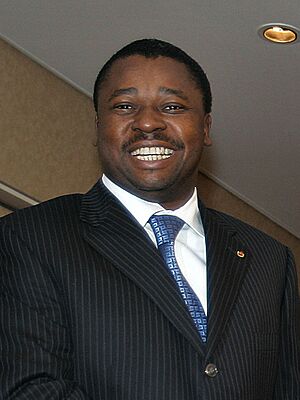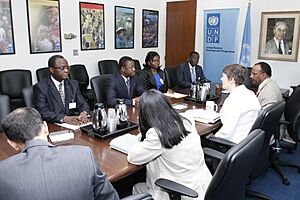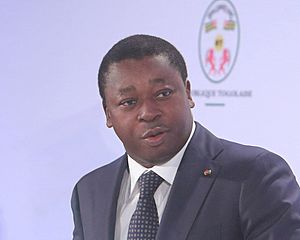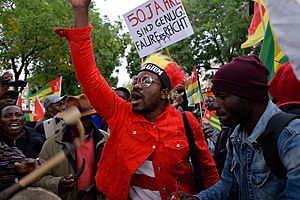Faure Gnassingbé facts for kids
Quick facts for kids
Faure Gnassingbé
|
|
|---|---|
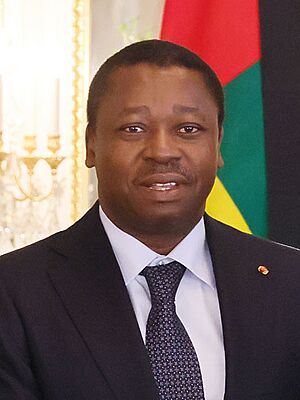
Gnassingbé in 2022
|
|
| 1st President of the Council of Ministers of Togo | |
| Assumed office 3 May 2025 |
|
| President | Jean-Lucien Savi de Tové |
| Preceded by | Office established; Victoire Tomegah Dogbé (as Prime Minister) |
| 4th President of Togo | |
| In office 4 May 2005 – 3 May 2025 |
|
| Prime Minister |
See list
Koffi Sama
Edem Kodjo Yawovi Agboyibo Komlan Mally Gilbert Houngbo Kwesi Ahoomey-Zunu Komi Sélom Klassou Victoire Tomegah Dogbé |
| Preceded by | Bonfoh Abass (acting) |
| Succeeded by | Jean-Lucien Savi de Tové |
| In office 5 February 2005 – 25 February 2005 |
|
| Prime Minister | Koffi Sama |
| Preceded by | Gnassingbé Eyadéma |
| Succeeded by | Bonfoh Abass (acting) |
| 10th President of the National Assembly of Togo | |
| In office 5 February 2005 – 25 February 2005 |
|
| Preceded by | Fambaré Ouattara Natchaba |
| Succeeded by | Bonfoh Abass |
| Minister of Equipment, Mines, Posts, and Telecommunications | |
| In office 29 July 2003 – 5 February 2005 |
|
| Prime Minister | Koffi Sama |
| Personal details | |
| Born | 6 June 1966 Afagnan, Togo |
| Political party | UNIR (since 2012) |
| Other political affiliations |
RPT (1990–2012) |
| Spouse | Ama Kufuor |
| Relations | Gnassingbé Eyadéma (father) Kpatcha (half-brother) |
| Alma mater | Paris Dauphine University George Washington (MBA) |
Faure Essozimna Gnassingbé (born 6 June 1966) is a politician from Togo, a country in West Africa. He has been a leader in Togo since 2005. From 2005 to 2025, he served as the fourth President of Togo. Since May 2025, he has been the first President of the Council of Ministers. He is a member of the ruling Union for the Republic (UNIR) political party. His father, Gnassingbé Eyadéma, was the third president of Togo.
Faure Gnassingbé was born in Afagnan. He studied in the United States and France. In 1990, he joined the Rally of the Togolese People (RPT) party. His father appointed him as the Minister of Equipment, Mines, Posts, and Telecommunications. He held these roles from 2003 to 2005.
After his father passed away in 2005, Gnassingbé became president with support from the army. He was also chosen as president of the National Assembly to make his leadership seem more official. However, there were questions about whether this was allowed by the country's laws. Because of this, other countries in the region put pressure on him. He then stepped down on 25 February 2005. Later, he won a presidential election on 24 April and was sworn in as president.
Gnassingbé ran for president three more times in 2010, 2015, and 2020. This was possible after a change to the country's laws in 2019. In 2024, Togo's constitution was changed again. These changes reduced the powers of the president and gave more power to the prime minister. The prime minister's role was renamed President of the Council of Ministers. This changed Togo from a presidential republic to a parliamentary system. The new rules also changed how the president is chosen. Instead of being chosen directly by the people, the president is now chosen by the Parliament.
These changes became active in May 2025. At that time, Faure Gnassingbé officially became the President of the Council of Ministers. A former opposition leader, Jean-Lucien Savi de Tové, became the new president. Some people who oppose the government have said these changes might allow Gnassingbé to stay in power for a very long time. Since June 2025, protests have grown, with people asking him to step down.
Contents
Early Life and Education
Faure Essozimna Gnassingbé was born in Afagnan, in the Lacs Prefecture. He is from the Kabye ethnic group. He is one of many children of former President Gnassingbé Eyadéma. His mother is Séna Sabine Mensah.
He went to high school in Lomé, the capital city of Togo. After that, he studied in Paris, France, at the Université Paris-Dauphine. There, he earned a degree in managing money for businesses. He then went on to get a Master of Business Administration (MBA) degree from The George Washington University in the United States.
In October 2002, he was chosen to be a Deputy for Blitta in the National Assembly of Togo. In the National Assembly, he helped lead a group that worked on selling government-owned businesses to private companies. On 29 July 2003, he became the Minister of Equipment, Mines, Posts, and Telecommunications. He held this job until he became president in February 2005.
Some people who opposed the government believed that a change to the constitution in December 2002 was made to help Gnassingbé. This change lowered the minimum age to be president from 45 to 35 years old. When he was appointed to the government in July 2003, he had already been seen with his father at official events. This made people think he was being prepared to take over from his father.
Presidency (2005–2025)
How Faure Gnassingbé Became President
President Eyadéma passed away suddenly on 5 February 2005. According to Togo's laws, the president of the National Assembly should have become the temporary president. At that time, the National Assembly president, Fambaré Ouattara Natchaba, was not in Togo. So, the Togolese Army quickly made Gnassingbé president. They said this was to keep the country stable. Many people thought Natchaba did not return to Togo because he feared for his safety. The army wanted him to step down so Gnassingbé could legally take power. The African Union, a group of African countries, said that Gnassingbé taking power was like a military takeover.
The day after his father's death, the National Assembly was told to remove Natchaba and choose Gnassingbé instead. This would make his leadership legal. This happened on 6 February 2005. All the members of the National Assembly who were there agreed to choose Gnassingbé. Most of them were from the ruling party. The opposition parties were not in the National Assembly because they had not taken part in the 2002 election. The members of Gnassingbé's party, the Rally of the Togolese People (RPT), did not want to go against the army's choice. The parliament also removed a rule that said elections had to be held within 60 days after the president's death. This allowed Gnassingbé to lead the country until his father's term would have ended in 2008.
Other countries in the region, especially Nigeria, put pressure on Togo. Later that month, Gnassingbé announced that new elections would be held within 60 days. But he said he would stay in office until then. However, on 21 February, the National Assembly changed some of the rules they had made to allow Gnassingbé to take power. They did not tell him to resign, but this was seen as a way to encourage him to step down gracefully. Changing the constitution during this time was against the law itself, but Gnassingbé's supporters did it anyway.
On 25 February, Gnassingbé was chosen by his party, the Rally for the Togolese People, to be their candidate for president. He was also chosen to lead the party. Soon after, because of growing pressure from inside and outside the country, Gnassingbé announced he would step down as president for a short time. Bonfoh Abass was then chosen by the National Assembly to be the temporary president until the election on 24 April.
Some people believed Bonfoh was controlled by the military and the Gnassingbé family. Gnassingbé ran against the main opposition candidate, Emmanuel Bob-Akitani. Bob-Akitani was a retired engineer and an important person in the opposition group. Another important opposition leader, Gilchrist Olympio, could not run. This was because the law said candidates had to live in Togo for at least 12 months. Olympio had been living outside the country because he feared for his safety.
In the election, official results showed that Gnassingbé received a little more than 60% of the votes. His party did not allow others to watch the counting of the votes. Groups like the European Union and the Carter Center said the elections were not fair. Large protests by opposition groups led to many people being killed by security forces. Thousands of people fled to nearby countries like Benin and Ghana.
Later Elections and Changes
Gnassingbé was re-elected for a second term in 2010. In the April 2015 presidential election, he won a third term. He defeated his main opponent, Jean-Pierre Fabre, with about 59% of the votes compared to 35% for Fabre. In the February 2020 presidential elections, Gnassingbé won his fourth term as president of Togo. Official results showed he won with about 72% of the votes. He defeated his closest challenger, former prime minister Agbeyome Kodjo, who had 18%. Many people questioned if these elections in Togo were fair.
Developing the Economy
To help Togo's economy, Faure Gnassingbé helped get money for building roads. He also worked on improving the country's buildings and structures. For example, new bridges were completed in Togblécopé and Amakpapé. He announced plans to develop the country during a visit to Belgium.
Protests and Term Limits
In 2019, the Parliament of Togo approved a new law. This law allowed Gnassingbé to stay in office until 2030. Despite this, many protests happened in the streets. People were asking for the end of his family's rule, which had lasted for 52 years at that time.
Togo's Relationships with Other Countries
On 18 June 2013, Gnassingbé met with Fra’ Matthew Festing. He was the leader of the Sovereign Military Order of Malta, a group that helps people. They talked about helping people in need. They also discussed Gnassingbé's efforts to improve Togo's help to others during his time as president.
In 2010, the Prime Minister of Japan, Yukio Hatoyama, congratulated Gnassingbé for winning the presidential election that year. In 2023, Gnassingbé met Fumio Kishida at a meeting between Japan and Togo. Kishida expressed his support for Gnassingbé for attending the funeral of former Japanese Prime Minister Shinzo Abe.
In 2025, the African Union chose Gnassingbé to help solve a conflict in the Democratic Republic of the Congo. He took over this role from the Angolan president, João Lourenço.
President of the Council of Ministers (2025–present)
In 2024, Togo's parliament approved changes to the country's laws. These changes turned Togo's presidential system into a parliamentary one. This meant that the president's role became more ceremonial, with fewer powers. The presidential term was also changed from five years to four, and a president could only be re-elected once. The role of the prime minister was renamed President of the Council of Ministers. Most of the powers that the president used to have were given to this new role. This made the President of the Council of Ministers the most powerful person in the country. This new way of governing was called the Fifth Republic of Togo.
The new system started on 3 May 2025. On that day, Gnassingbé was sworn in as President of the Council of Ministers. Jean-Lucien Savi de Tové, who had been an opponent of Gnassingbé's father, was elected by the National Assembly and members of the Senate. He became the country's first ceremonial president.
People who oppose the government have criticized these changes. They believe it is a way for Gnassingbé to stay in power because the President of the Council of Ministers has no term limits. They also said that Gnassingbé moved to this role to keep his family's control over the country. In June 2025, soon after Gnassingbé became President of the Council of Ministers, many young people led protests against him. They demanded that he step down.
See also
 In Spanish: Faure Gnassingbé para niños
In Spanish: Faure Gnassingbé para niños
- History of Togo
- Politics of Togo


